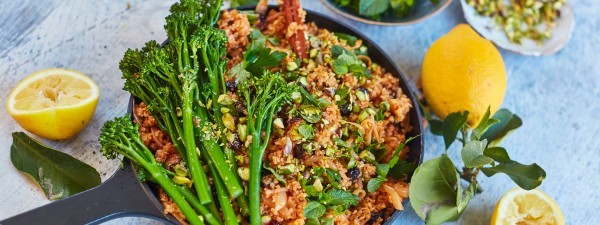So, What are Traditional Greek Ingredients?
- Olive oil - the very foundation of Greek cuisine. Olive oil is used as a cooking oil in the kitchen, as a dipping oil for bread and also as a garnish: drizzled over salads, freshly cooked fish, vegetables and pulses.
- Olives – Naturally, you can’t have olive oil without the olives. Olive trees are found all over Greece and their olives are some of the best in the world. Served up with salads, cooked with fish or stewed into a sauce, there is no end to how olives are used in Greek cuisine. They even make an excellent snack - stuffed with fresh herbs, garlic or lemon.
- Fresh Fish (and Octopus) – as you’d expect from a country surrounded by the Mediterranean Sea and made up of many islands, fresh fish features heavily in the Greek diet. This is especially true of abundant oily fish such as mackerel, sardines and anchovies, but extends to mussels and meatier fish such as sea bream and sea bass. But even more so than fish, octopus plays a huge part in Greek food. Cooked in a variety of ways, octopus is eaten all over the country.
- Feta Cheese – the most commonly known and exported cheese from Greece. Feta is a cheese that comes with a Protected Designation of Origin, meaning it can only be produced in certain areas of Greece. Much like over here, a Cornish pasty can only be produced in Cornwall.
- Wine – Greece is one of the oldest wine producing regions in the world, so it goes without saying that it’s a traditional part of the cuisine. There is wide range of both red and white wines, the most famous of which is Retsina.
- Yogurt - one of the country’s greatest exports. You might be more used to having it with your granola in the mornings, but in Greece it also forms the basis of their tangy tzatziki sauces, used as a condiment for spicy kebabs or even just a simple dipping sauce for bread.
- Lamb – although the country is surrounded by the Mediterranean Sea, many of the country’s famed dishes such as moussaka and kebabs rely on the land for its key ingredient – lamb.
- Herbs – Oregano is most commonly used in Greek food. Served up in Greek salads, added as a flavouring to olive oil or cooked with meat or fish, it’s an ingredient that can be used extensively. Rosemary and thyme are also widely used in Greek cuisine.
Is Greek Food Healthy?
Made up of these fresh Mediterranean ingredients, the Greek diet is generally very healthy.
By incorporating Greek staples such as olive oil, seafood, herbs, fruits, vegetables into your diet, you will be likely to have a healthy lifestyle.
Traditional Greek Meals
So, how do Greek ingredients come together to create delicious, distinct, and traditional Greek food?
There are a few meals that really stand out as some of the best and most authentic Greek food:
- Moussaka - Layers of aubergine and minced lamb combine in this very pleasing traditional Greek dish. Topped with béchamel sauce and baked until the top layer is nicely browned.
- Greek Salad - The addition of olives, feta cheese and oregano to other classic salad ingredients such as tomatoes, cucumber, peppers and salad leaves makes a Greek salad distinctive. Dressed with olive oil and perhaps a touch of lemon, a Greek salad really does epitomise Mediterranean ingredients.
- Tzatziki - A super easy mix of Greek yoghurt, cucumber and garlic, typically served as a side dish to meat dishes.
- Dolmades - This traditional vine leaf parcel often consists of minced meat or vegetarian versions of rice mixed with favoured Greek herbs such as oregano and thyme.
- Orzo (Kritharaki)
- Kritharaki is a Greek dish of short-cut pasta with a tomato sauce. Georgina Hayden created this one pot orzo recipe with Tenderstem® broccoli and olives that you can try at home.

One pan orzo with Tenderstem® broccoli and olives - Taramasalata - This simple yet delicious traditional Greek dish is a blend of fish roe with stale bread and flavourings such as lemon, olive oil and herbs.
- Baklava - Made with traditional Greek honey, Baklava is a sweet dish of filo pastry layered with chopped nuts.
Greek Recipes with Tenderstem® Broccoli

Pilafi is a classic side dish and can often be found featuring in mezes, alongside Sunday roasts and even accompanying kebabs. You’ll find lots of variations, sometimes with smashed up fried vermicelli through it, but often simply cooked in tomato and not much else. Eat it as the Greeks would do — with a nice dollop of fresh Greek yoghurt on the side.
- Share via Twitter
- Share via Facebook
- Share via Pinterest
-
Copy to your clipboard



